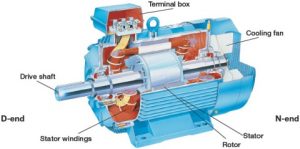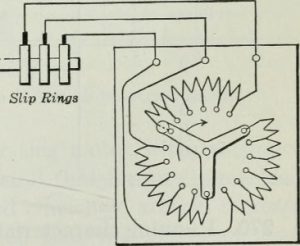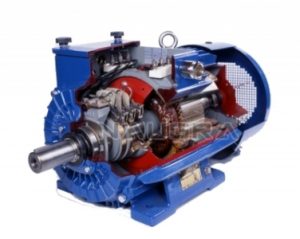The name itself suggests us on what principle it works. Induction Motor(IM) operates on the induction type principle where the current from primary winding is transferred to the secondary winding. It operates similar to that of a transformer but the difference is that IM is a rotating machine and Transformer is a stationary machine. This induction type rotating machines further classified into different types based on its construction. Different construction is done to keeping in view to advance its advantages and applications. In this article, we shall discuss this motor’s construction, working, speed control, advantages, disadvantages, and applications.
What is Slip Ring Induction Motor?
Definition: It is a type of motor where its external circuit is connected using some rings. This rings attached with high resistance acts as an external circuit for the rotor. This external circuit helps in developing a high starting torque compared to a squirrel cage type.
Construction
The construction of this motor is similar to that of a squirrel cage motor. But there is a small difference in the construction of its rotor. In squirrel cage type, we use rotor bars but in-ring type, we use windings that are connected in star. These windings are connected to the rings. By using rings, a high resistance is connected in series to the rings which act as an external circuit. The slip ring-type motor is shown in the figure below.

Parts of the Motor
Working of Slip Ring Induction Motor
The working of this motor is similar to that of a normal motor. Except some additional functions takes place in this motor which adds an advantage. When a three-phase power supply is given to the stator of a three-phase motor.
An RMF is produced which rotates in the air gap present in the stator. This RMF cuts the rotor windings I,e whenever a current-carrying conductor is influenced by a magnetic field an emf will be induced. Similarly, when this RMF cuts the current-carrying rotor windings an emf will be induced by the principle of electromagnetic Induction. This induced EMF will produce a force stated by Lorentz. This EMF produced will develop torque which should be able to rotate the rotor. The developed torque is not unidirectional to rotate the rotate. As the motor is inductive, the phase difference developed is also high. The working of the motor connection diagram is shown in the figure below.

Connection Diagram
The phase difference between the current and voltage is not sufficient to develop high starting torque. To increase the phase difference the motor is provided with some rings through which high resistance is connected in series with the circuit. Because of this high resistance, he inductive reactance is decreased such that the phase difference the current and voltage is also decreased. Therefore, due to the decrease in phase difference the motor can able to develop high starting torque.
Why Slip Ring Induction Motor are Used?
These are used in increasing the starting torque of the motor. Slips rings are connected to the external high resistance circuit. The addition of these rings along with the external high resistance increases the resistance and decreases the inductive reactance. The function of a three-phase slip ring induction motor is shown in the figure below.

Three-phase Slipring
Due to the decrease in the inductive reactance, the phase difference between the current and EMF induced will be reduced. So, a proper unidirectional torque is produced which can develop high starting torque.
Speed Control of Slip Ring Induction Motor
1) By Varying External Resistance: We know that a motor uses an external high resistance circuit for producing high starting torque. The resistance of this motor depends upon the slip, and independent of the torque. So, by varying resistance after the motor has attained rated speed, the slip value can be increased keeping the torque constant.
Therefore, with the increase in the slip, the speed can be varied because the slip value depends on the speed. As the slip value increases the speed of the motor decreases with maintaining constant torque and this is possible only in ring-type.
2) Using Thyristor Circuit: The Speed control of this motor is controlled by using a thyristor ON/OFF circuit. It is controlled by varying the rotor current of the motor. As rotor current is directly proportional to the speed and torque of three-phase ring-type. To achieve this, the rotor AC current is converted by means of a three-phase bridge rectifier circuit. Further, the rotor current is controlled by using a thyristor giving control as per the requirement. The main advantage of using this thyristor circuit is we can avoid operational losses. So, this method of control is very efficient.
Difference Between Squirrel Cage and Ring-type
Almost the construction of squirrel cage and ring-type remains similar. But due to some disadvantages of squirrel cage motor like low starting torque and high phase difference a ring-type is designed. Though the design of the motor is quite difficult, it has a high starting torque compared to the squirrel type. Apart from the design difference, rings connected to the high resistance also could decrease the phase difference.
Advantages
- Low starting current
- Good speed control
Disadvantages
- Cost is high
- High Maintenance
- Complex design
- Undergoes more repairs.
- Operational losses.
Applications
- Used in Hoists, elevators, printing presses, and industrial purposes.
Please refer to this link to know more about Slip Ring Motor MCQs.
Thus, in this article, we had an overview of a ring-type motor. It is designed to overcome the disadvantages of squirrel type. This type of motor can develop high starting torque compared to the squirrel cage type. Apart from this, we had also discussed the construction, working, why rings are used, the difference between the ring and squirrel cage type, speed control of ring type, advantages, disadvantages, and applications. Here is a question for the readers, how can we calculate the resistance of IM?
Pictures Credit
Leave a Reply